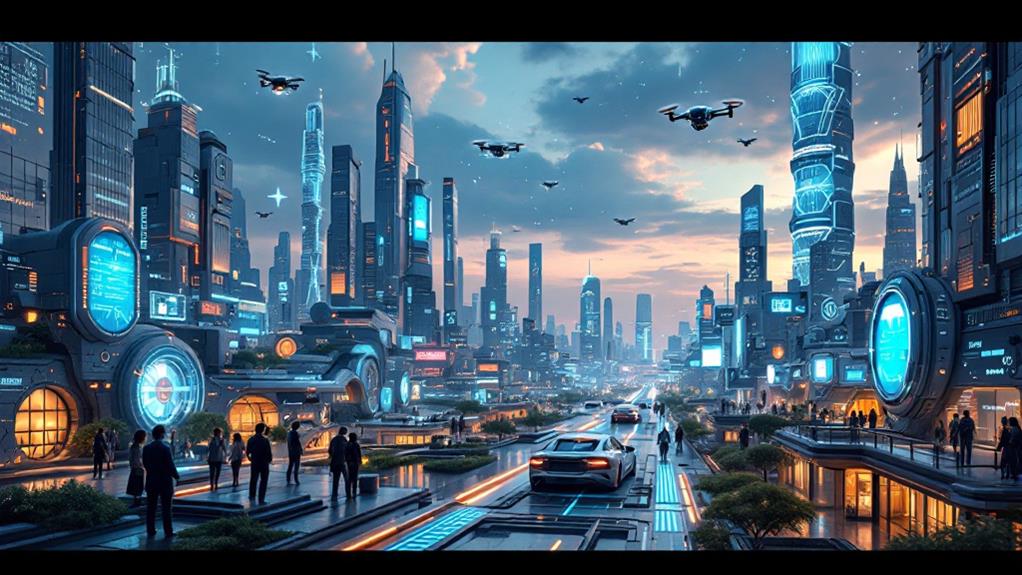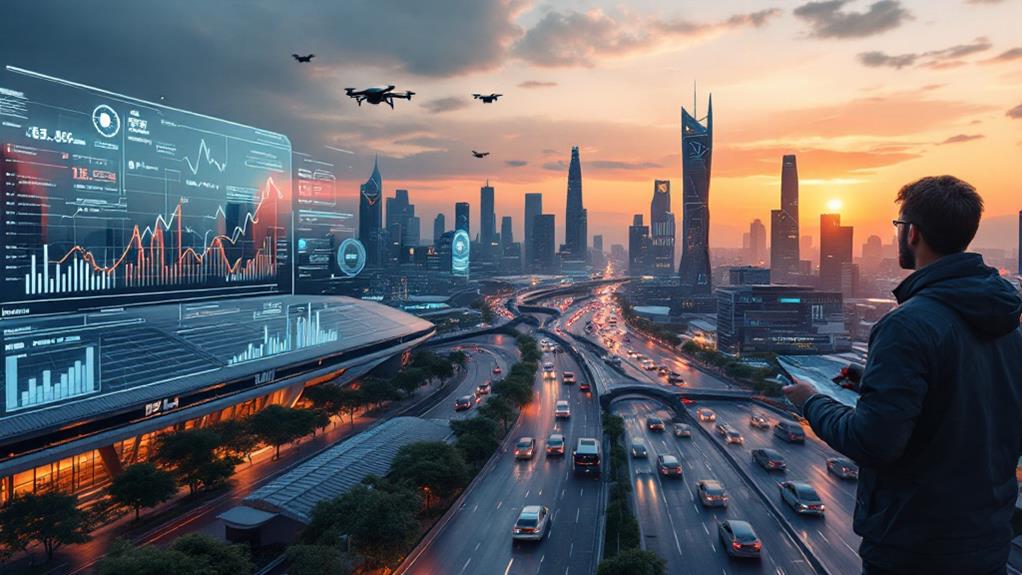How Technology Is Transforming the Largest Urban Areas

You're witnessing an incredible transformation in urban areas as technology reshapes city living. IoT sensors are everywhere, gathering data to improve infrastructure and resource management. AI optimizes traffic flow and augments public transit, reducing congestion and wait times. Healthcare systems are leveraging AI and telemedicine to elevate patient care. Revolutionary transportation changes include autonomous and electric vehicles, driven by AI for smarter transit routes. Civic platforms are empowering community involvement, enhancing engagement in city planning. As cities become smarter, they face challenges like data privacy and cybersecurity. There's so much more to uncover about these technological impacts in urban life.
Evolution of Smart Cities
Smart cities are increasingly transforming urban landscapes by integrating creative technologies to improve everyday life. You're witnessing a revolution in urban infrastructure, driven by the Internet of Things (IoT), where Seoul is leading the charge. With plans to install over 50,000 IoT sensors, the city aims to optimize urban metrics and energy consumption. These sensors are essential for developing data-driven solutions that elevate sustainability. In Amsterdam, over 70 smart city projects are managed through the Amsterdam Smart City platform, showing how data can meaningfully improve urban living.
AI-powered transit systems are also reshaping your daily commute. By dynamically adjusting routes based on real-time data, these systems minimize wait times and increase efficiency in public transit. This technology transforms urban mobility, making your travel smoother and more predictable. Additionally, smart waste management in cities like Singapore uses sensors to optimize waste collection routes, reducing costs and environmental impact.
Urban agriculture is another facet of smart cities, with vertical farming and sensor integration maximizing space and promoting local food production. This not only improves food security but also fosters a sustainable urban environment. With these advancements, smart cities are certainly the future of urban living.
Core Technologies in Urban Areas
Urban innovation is thriving with core technologies like the Internet of Things (IoT) driving real-time data collection and analysis. In major urban areas, these technologies optimize resource management, making city life more sustainable. IoT plays a crucial role in smart traffic management systems, where real-time data collection allows for dynamic adjustments to signal timings. This results in reduced congestion and smoother vehicle flows, improving your commute experience.
Smart grids are another essential technology, integrating renewable energy sources into electricity distribution. They promote energy efficiency and sustainability within urban environments, cutting operational costs for you as a consumer. By improving the user experience, smart grids help you access cleaner, more affordable energy.
Data analytics is transforming waste management by optimizing collection routes and schedules. This not only increases operational efficiency but also minimizes environmental impact. Advanced sensor networks guarantee waste is collected when necessary, keeping your city cleaner and more livable.
Lastly, context-aware computing technologies allow for localized data analysis, guaranteeing urban systems respond quickly to user needs. This improves your experience with city services, making them more intuitive and responsive to your requirements. These core technologies collectively enhance urban living by making it smarter and more efficient.
AI and Big Data Impact

In many ways, AI and Big Data are transforming city life by improving how urban environments operate. You're seeing changes in urban management as AI analyzes data from IoT sensors to optimize traffic patterns and predict utility demands. This means smarter decisions, less congestion, and enhanced public safety responses. Cities like Seoul are at the forefront, investing $1.24 billion to install 50,000 IoT sensors. These initiatives collect and analyze data to optimize urban metrics and improve energy efficiency, driving cities toward smart energy management.
Smart energy management systems, powered by AI, help reduce carbon footprints by integrating renewable energy sources and optimizing electricity usage in real time. This not only benefits the environment but also supports sustainable urban growth. AI-powered public transit systems also play a role, dynamically adjusting routes based on real-time data. This minimizes wait times, increases transit efficiency, and encourages more citizens to use public transport.
However, with all this data collection, data privacy becomes a vital concern. It's important for cities to address these concerns through transparent governance, ensuring citizen participation and trust in the systems that are designed to make their lives better.
Innovations in Urban Healthcare
The landscape of urban healthcare is witnessing a remarkable transformation, thanks to a myriad of technological innovations. Remote Patient Monitoring (RPM) systems are at the forefront, using digital technology to track the health data of patients. This is especially beneficial for those dealing with chronic conditions, enhancing patient engagement by allowing you to actively participate in your health management. Telemedicine has surged, particularly during public health crises, enabling you to access healthcare services without the need for physical travel, thereby saving time and effort.
AI-powered diagnostic tools are altering urban healthcare settings by streamlining processes and improving the accuracy of patient care. These tools analyze complex data quickly, offering insights that might otherwise take significant time to uncover. Digital health records play an essential role by ensuring seamless information sharing among healthcare providers. They empower you with better access to your health information and treatment history, making healthcare more transparent and efficient.
Mobile health applications are another significant urban healthcare innovation. They improve access to health services and enhance patient engagement, ultimately impacting public health outcomes positively. In densely populated areas, these technologies are reshaping how you experience healthcare, making it more accessible and efficient.
Transportation Revolution

Amidst the rapidly evolving urban landscape, transportation is undergoing a significant revolution. You're witnessing a shift in urban mobility with autonomous vehicles leading the charge. Companies like Waymo are already testing these vehicles in cities such as San Francisco, promising a future where traffic congestion is reduced and trust in public transport soars. Electric vehicles (EVs) are also gaining momentum, with urban areas prioritizing charging infrastructure to encourage their adoption. This not only supports sustainability initiatives but also transforms the transportation planning landscape.
Smart public transit systems are utilizing AI to optimize routes and schedules based on real-time data. This means you spend less time waiting and more time reaching your destination efficiently. Integrated multi-modal transit systems are further improving urban mobility by seamlessly connecting buses, trains, and bike-sharing services. They make city navigation effortless and convenient for you.
Digital platforms are at the heart of this transformation. By providing real-time data for route optimization, these platforms improve your travel experience and elevate public transit usage. As cities adopt this transportation revolution, expect more efficient and eco-friendly urban environments designed with you in mind.
Enhancing Civic Engagement
While urban mobility is rapidly evolving, the transformation doesn't stop there. Across the globe, digital platforms are changing civic engagement and participatory governance, giving you a direct voice in urban development. Imagine having the power to influence how your city's budget is allocated. Over 1,000 cities worldwide, including Paris and New York, are already empowering citizens like you to shape their environments. In Paris, the Lutece platform offers over 200 digital services, enhancing interaction between residents and local government.
In New York City, interactive apps provide a channel for you to give feedback on urban initiatives, promoting transparency and community participation. As a resident, you gain ownership over your city's development, guaranteeing your input helps shape its future. Singapore is another shining example, integrating feedback mechanisms into smart city projects, resulting in over 80% satisfaction in public engagement.
Cities like Barcelona showcase successful models where digital platforms facilitate community discussions, allowing you to take part in urban planning initiatives. This shift towards greater transparency and citizen involvement guarantees that urban development aligns with the needs of its residents, creating more lively and inclusive communities.
Overcoming Technological Challenges

How can cities truly thrive in the technological age without addressing the technological challenges that accompany smart city initiatives? To tackle urban challenges effectively, you must prioritize robust cybersecurity measures. The data-driven nature of today's urban environments makes them vulnerable to security breaches and data privacy violations. Without adequate protections, the promise of smart city services can quickly turn into a liability.
Equally significant is preventing the digital divide from widening. Guaranteeing equitable access to technology is fundamental, as disparities among socioeconomic groups can lead to unequal benefits from smart city innovations. Without targeted efforts, some residents may be left behind, unable to access critical services.
Collaboration among diverse stakeholders is imperative for overcoming these obstacles. By integrating expertise from different sectors, you can develop inclusive, effective solutions. Stakeholder collaboration guarantees that smart city services are designed to meet the assorted needs of the community.
Continuous evaluation and adaptation are key to maintaining the relevance and efficiency of these technologies. Regular assessments help you secure that benefits are fairly distributed and allow for prompt responses to emerging challenges. Welcome ongoing learning to stay ahead in the constantly changing landscape of smart cities.



